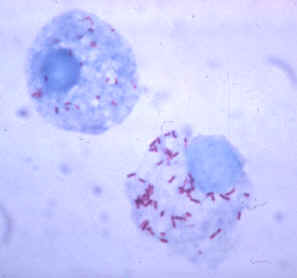- Rickettsia
Taxobox
color = lightgre
name = "Rickettsia"

image_caption = "Rickettsia rickettsii"
brown = Bacteria
phylum =Proteobacteria
classis = Alpha Proteobacteria
ordo =Rickettsiales
familia =Rickettsiaceae
genus = "Rickettsia"
genus_authority = da Rocha-Lima, 1916
subdivision_ranks = Species
subdivision ="Rickettsia felis " "Rickettsia prowazekii " "Rickettsia rickettsii " "Rickettsia typhi " "Rickettsia conorii " "Rickettsia africae " "Rickettsia akari " etc."Rickettsia" is a
genus of motile,Gram-negative , non-sporeforming, highlypleomorphic bacteria that can present ascocci (0.1 μm in diameter), rods (1-4 μm long) or thread-like (10 μm long).Obligate intracellular parasites , the "Rickettsia" depend on entry, growth, and replication within thecytoplasm of eukaryotic host cells (typically endothelial cells).cite book | author = Walker DH | title = Rickettsiae. "In:" Barron's Medical Microbiology "(Barron S "et al", eds.)| edition = 4th ed. | publisher = Univ of Texas Medical Branch | year = 1996 | id = [http://www.ncbi.nlm.nih.gov/books/bv.fcgi?rid=mmed.section.2078 (via NCBI Bookshelf)] ISBN 0-9631172-1-1 ] Because of this, "Rickettsia" cannot live in artificial nutrient environments and are grown either in tissue orembryo cultures (typically, chicken embryos are used). In the past they were regarded as microorganisms positioned somewhere between viruses and true bacteria. The majority of "Rickettsia" bacteria are susceptible toantibiotic s of thetetracycline group."Rickettsia" species are carried as
parasite s by manytick s,flea s, andlice , and causedisease s such astyphus ,rickettsialpox ,Boutonneuse fever ,African Tick Bite Fever ,Rocky Mountain spotted fever ,Australian Tick Typhus ,Flinders Island Spotted Fever andQueensland Tick Typhus [cite journal |author=Unsworth NB, Stenos J, Graves SR, "et al" |title=Flinders Island spotted fever rickettsioses caused by "marmionii" strain of Rickettsia honei, Eastern Australia |journal=Emerging infectious diseases |volume=13 |issue=4 |pages=566–73 |year=2007 |month=April |pmid=17553271 |doi= |url=] in human beings. They have also been associated with a range of plant diseases. Likevirus es, they only grow inside living cells. The name rickettsia is often used for any member of theRickettsiales . They are thought to be the closest living relatives to bacteria that were the origin of themitochondria organelle that exists inside mosteukaryotic cells.The method of growing Rickettsia in chicken embryos was invented by
Ernest William Goodpasture and colleagues atVanderbilt University in the early 1930s.Human pathogenesis
The "Rickettsia" human pathogens are generally grouped as follows:
Spotted fever group
:* "R. rickettsii" (Western hemisphere)::
Rocky Mountain spotted fever :* "R. akari" (USA, former Soviet Union)::
Rickettsialpox :* "R. conorii" (Mediterranean countries, Africa, Southwest Asia, India)::
Boutonneuse fever :* "R. siberica" (Siberia, Mongolia, northern China):: Siberian tick typhus
:* "R. australis" (Australia)::
Australian tick typhus :* "R. japonica" (Japan):: Oriental spotted fever
:* "R. africae" (South Africa):: African Tick Bite Fever
Typhus group
:* "R. prowazekii" (Worldwide):: Epidemic, recrudescent and sporadic
typhus :* "R. typhi" (Worldwide):: Murine (endemic) typhus
Scrub typhus group
:* The causative agent of
scrub typhus formerly known as "R. tsutsugamushi" has been reclassified into the genus "Orientia ".Plant pathogenesis
The following plant diseases have been associated with Rickettsia-like organismscite book | author = Smith IM, Dunez J, Lelliot RA, Phillips DH, Archer SA| title = European Handbook of Plant Diseases. | publisher = Blackwell Scientific Publications| year = 1988 | id = ISBN 0-632-01222-6] .
:* Beet latent Rosette RLO:* Citrus Greening bacterium:* Clover leaf RLO:* Grapevine infectious necrosis RLO:* Grapevine Pierce's RLO:* Grapevine yellos RLO:* Larch witche's broom disease:* Peach phoney RLO
Genomics
Certain segments of Rickettsial
genome s resemble that ofmitochondria .cite journal | author=Emelyanov VV | title=Mitochondrial connection to the origin of the eukaryotic cell | journal=Eur J Biochem | year=2003 | pages=1599–618 | volume=270 | issue=8 | pmid=12694174 | doi = 10.1046/j.1432-1033.2003.03499.x] The deciphered genome of "R. prowazekii" is 1,111,523 bp long and contains 834 protein-codinggenes .cite journal | author=Andersson SG, "et al" | title=The genome sequence of Rickettsia prowazekii and the origin of mitochondria | journal=Nature | year=1998 | pages=133–40 | volume=396 | issue=6707 | pmid=9823893 | doi=10.1038/24094 ] Unlike free-living bacteria, it contains no genes foranaerobic glycolysis or genes involved in the biosynthesis and regulation ofamino acid s andnucleoside s. In this regard it is similar to mitochondrial genomes; in both cases, nuclear (host) resources are used. ATP production in "Rickettsia" is the same as that in mitochondria. In fact, of all the microbes known, the "Rickettsia" is probably the closest "relative" (inphylogenetic sense) to the mitochondria. Unlike the latter, the genome of "R. prowazekii", however, contains a complete set of genes encoding for thetricarboxylic acid cycle and therespiratory chain complex. Still, the genomes of the Rickettsia as well as the mitochondria are frequently said to be "small, highly derived products of several types of reductive evolution".The recent discovery of another parallel between "Rickettsia" and viruses may become a basis for fighting
HIV infection. [cite journal | author=Kannangara S, DeSimone JA, Pomerantz RJ | title=Attenuation of HIV-1 infection by other microbial agents | journal=J Infect Dis | year=2005 | pages=1003–9 | volume=192 | issue=6 | pmid=16107952 | doi = 10.1086/432767] Human immune response to thescrub typhus pathogen, "Orientia tsutsugamushi " rickettsia, appears to provide a beneficial effect against HIV infection progress, negatively influencing the virus replication process. A probable reason for this actively studied phenomenon is a certain degree of homology between the rickettsia and the virus - namely, commonepitope (s) due to common genome fragment(s) in both pathogens. Surprisingly, the other infection reported to be likely to provide the same effect (decrease in viral load) is the virus-caused illnessdengue fever .Naming
The genus "Rickettsia" is named after Howard Taylor Ricketts (1871–1910), who studied and eventually died of typhus. Despite the similar name, "Rickettsia" bacteria do not cause
rickets . The disease of rickets takes its name from the Greek word for spine, "hrake", and is a vitamin D deficiency disease, not an infectious disease.References
External links
* [http://patric.vbi.vt.edu/organism/overview.php?organismId=3 Rickettsia] (from [http://patric.vbi.vt.edu/ PATRIC] the PathoSystems Resource Integration Center, a [http://www3.niaid.nih.gov/ NIAID] Bioinformatics Resource Center)
* [http://www.cdc.gov/ncidod/EID/vol12no09/05-1540.htm African Tick Bite Fever] from the [http://www.cdc.gov/ncidod/eid/ Centers for Disease Control and Prevention] .
Wikimedia Foundation. 2010.
